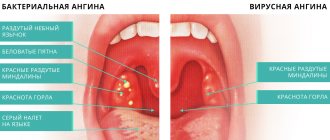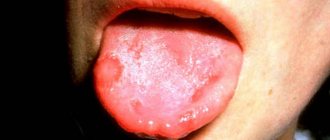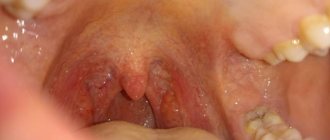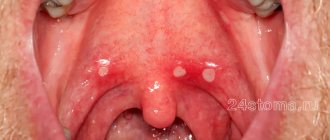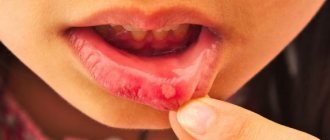Aphthous stomatitis is an inflammatory disease of the oral cavity in which single or multiple ulcers appear on the mucous membrane. These pathological formations are also called aphthae (from the Greek aphta - sore). They can occur on any part of the oral mucosa. The ulcers are painful and gradually heal.
Although in most cases aphthous stomatitis is not a contagious disease (provided it is not caused by viruses or bacteria), it is one of the most common inflammatory pathologies of the oral cavity. It is detected in 10-40% of children and adults worldwide.
If you have symptoms of aphthous stomatitis, you should definitely consult a doctor. An infection can penetrate into the aphthae, which will significantly complicate the course of the pathological process. In addition, the presence of ulcers affects the patient’s psycho-emotional state and significantly reduces his quality of life.
Types of stomatitis and the main reasons for its occurrence
There are many types of stomatitis. Based on the causative agent of the disease, a specific type of treatment is selected. A white sore may appear in single or multiple quantities on the tonsil for the following reasons:
- taking certain medications (usually antibiotics, which provokes a fungal form of pathology); herpetic lesions (aphthous stomatitis); trauma to the mucous membrane (rough food, foreign objects, hot food, chemicals); viral lesions (vesicular stomatitis, transmitted by airborne droplets); bacterial diseases (catarrhal stomatitis) and so on.
In everyday life, the disease most often occurs due to injury or due to the constant presence of infection (caries, runny nose, adenoiditis). In children, stomatitis can occur due to the constant presence of foreign objects in the mouth during teething.
Disease prevention
Regular oral hygiene.
Flossing twice a day or every time after meals will help remove food debris from your mouth and reduce the number of germs that irritate the mucous membrane and increase the risk of developing stomatitis. You need to be careful when cleaning the spaces between your teeth so as not to scratch your gums, as this can lead to the appearance of new ulcers.
Replacing toothpaste.
Canker sores can occur in people who use toothpastes containing sodium lauryl sulfate. This foaming component dries out the oral mucosa, which leads to a decrease in local immunity and increases the risk of developing the disease.
Therefore, for daily hygiene it is recommended to use products that do not contain sodium lauryl sulfate.
Changing your diet.
To prevent the disease, people prone to relapses of aphthous stomatitis are recommended to limit the consumption of foods that can irritate the oral mucosa (milk, coffee, cheese, tomatoes, sour fruits, chocolate, etc.). It is necessary to exclude salty and spicy dishes from the daily menu, which also have a negative effect on the soft tissues in the oral cavity. To avoid scratching the mucous membrane, you should be careful when eating hard cookies, crackers, chips and other hard foods.
Up to contents
Diagnosis of pathology
A doctor can assess why stomatitis appears on the tonsil and make the correct diagnosis during a routine examination. No additional manipulations or analyzes are usually required.
For each type of disease, appropriate therapy is used. If you want to get rid of the pathology quickly and correctly, you should consult a doctor. When diagnosing the disease, the following factors are taken into account:
- age and lifestyle of the patient; presence of additional stimulants of the disease; localization and area of rashes; additional symptoms in the form of fever, runny nose, enlarged tonsils, chronic diseases.
What to do if you suddenly notice a white ulcer on your tonsil? Many patients will suspect a sore throat.
But they will not always be right. Treatment of stomatitis and tonsillitis differs significantly. This is why it is so important to make a correct diagnosis.
Therapy of the disease consists of the use of symptomatic remedies that alleviate the patient’s discomfort and the use of medications that affect the cause of the disease. Folk recipes and grandmother’s methods of treating stomatitis are also very popular. Let's look at effective options in more detail.
Classification of stomatitis
Stomatitis can be classified according to the form of the disease:
- Catarrhal. The lightest form. We can cure it at home. The cause of the appearance, as a rule, is insufficient oral hygiene, often observed with tooth decay. Upon visual examination, only redness is noticeable, there are still no ulcers.
- Aphthous. It is characterized by the appearance of ulcers, or aphthae, on the mucous membrane of the throat. They have a small diameter, up to one and a half centimeters, round or oval shape, and have a bright inflamed outline. They are covered with a bubble, but it can often not be seen, as they quickly burst. The color of the ulcer itself is pale, white-gray. Aphthous stomatitis can be acute or chronic. Acute is characterized by severe pain in the throat area and increased temperature. People with weak protective functions of the body are susceptible to chronic disease.
- Fungal. Most often, it affects children under one year of age whose immunity has not yet strengthened, or people with reduced immunity due to old age. The visual difference is a cheesy coating on the ulcers. Localized at the back of the throat.
- Bacterial. The causative agent is bacteria. Bacteria that enter the body through the mouth quite simply settle in the throat and provoke the occurrence of stomatitis. They appear in the form of pustules that quickly develop into ulcers.
- Viral. Caused by the herpes virus. It is characterized by rashes of small blisters, which burst when exposed to secondary bacterial flora.
- Ray. A consequence of radiation sickness, strong radiation. It manifests itself as ulcers in the throat, thickening of the mucous membrane. Examination and diagnosis.
First of all, if stomatitis is suspected, the doctor will visually examine the oral cavity and throat. The following will be assessed:
- mucous membrane of the throat;
- number, shape, size and location of damaged areas;
- presence or absence of plaque;
- the nature of the plaque on the inflamed surface.
This will be followed by a detailed examination to determine how to treat stomatitis in the throat:
- general blood analysis;
- a smear from the mucous membrane of the throat for bacterial culture (allows you to identify the causative agent of stomatitis in order to direct treatment towards its elimination).
If stomatitis is chronic and constantly recurs, diagnosis will include additional laboratory tests:
- blood biochemistry;
- blood sugar test (to check whether the patient has diabetes, against which stomatitis often develops);
- saliva analysis to identify the pathogen.
To determine the pathogen, you need to undergo an examination
Use of painkillers and antipyretics
Very often, stomatitis on the tonsil is accompanied by high body temperature and terrible pain.
A person cannot eat normally, it is even difficult to drink. But drinking plenty of fluids and eating nutritious food is an important condition for a quick recovery. A variety of over-the-counter antipyretics can be used to reduce fever:
- based on ibuprofen (Nurofen, Burana, Advil) - these drugs are the most popular today, they can be used in infants, but only in the form of syrups and suppositories; products with paracetamol (Panadol, " Efferalgan") - have been known for a long time, act quickly, but negatively affect the functioning of the liver (people with diseases of this organ are not recommended to use); medications with nimesulide ("Nise", "Nimulid", "Nimesil") - effectively and permanently eliminate fever, but they have a negative effect on the gastrointestinal tract, so they should be taken only after meals.
All of the drugs mentioned have an analgesic effect to a greater or lesser extent.
But practice shows that medications based on diclofenac and ketorolac (“Ketorol”, “Ketanov”, “Diclovit”) are most effective in eliminating this symptom. These medications should be taken no more than 3-5 days in a row. Medicines have a symptomatic effect, but do not affect the cause of the disease in any way.
Antiseptics and their names
If stomatitis appears on the tonsils, then doctors almost always prescribe antiseptic drugs. Such medications prevent the proliferation of pathogenic microorganisms and eliminate existing viruses, fungi and bacteria. The following remedies can be used at home:
- “Miramistin” or “Chlorhexidine” (the latter must be diluted before use) - the drugs eliminate the growth of bacteria, viruses and fungi, so you can’t go wrong with this medicine. Zelenka is an outdated, but proven remedy for the treatment of stomatitis, treatment of ulcers is done pointwise. Lugol - one of the most effective means for treating tonsils, treatment is carried out with a sterile cotton swab soaked in a solution. “Fukortsin” - has an antimicrobial and antifungal effect, promotes rapid tightening of aphthae and improvement of well-being. “Hexoral” - effective if stomatitis on the tonsil is caused by a herpetic infection, it is applied using a spray and has a pleasant taste. “Tantum Verde” is a spray that has an antiseptic and analgesic effect, suitable for use even in pregnant women.
All antiseptics must be used carefully. Many of the drugs described have a drying effect, which can be harmful if used excessively.
Aphthous stomatitis - symptoms and treatment
The doctor’s task in the treatment of aphthous stomatitis is to achieve stable remission, or clinical or complete recovery.
In the treatment of this disease, an integrated approach is extremely important, which should include general and local therapy and competent selection of medications. Their choice depends on the form of stomatitis and the severity of the disease.
One of the stages is local treatment. It involves treating aphthae with antiseptic and healing agents, carrying out antiseptic rinses and using anti-inflammatory gels. Today, the most effective and efficient medicines are:
- "Miramistin" - used for antiseptic treatment of the oral cavity.
- "Cholisal" - is used at the initial stage of the disease to eliminate pain.
- "Kamistad", "Trasilol", clobetasol - anti-inflammatory ointments with an anesthetic.
- "Diphenhydramine" - prescribed for allergic reactions.
- “Tantum Verde”, “Hexoral” are antibacterial agents recommended for secondary infection.
- "Stomatofit-A" is an anesthetic balm to combat canker sores.
- “Solcoseryl-gel” is an epithelializing agent, used after the disappearance of ulcers [10].
During exacerbations, enzymes such as trypsin, chymotrypsin and RNase must be applied topically to remove necrotic plaque from the surfaces of erosions. The process of epithelization is significantly accelerated by such agents as solutions of citral, vitamin C and P, preparations with Kalanchoe and propolis juice. The use of corticosteroid ointments prevents further development of aphthae and speeds up the healing process.
When treating stomatitis, you should pay attention to strengthening the immune system and the general condition of the body, this allows you to more successfully fight the disease.
It is recommended to take antihistamines internally - clemastine, loratadine, fexofenadine, since in many cases the causes of aphthous stomatitis can be food allergens or components of hygiene products (such as sodium lauryl sulfate). To eliminate swelling and inflammation, it is recommended to use desensitizing drugs - quifenadine and histamine with immunoglobulin. If the body’s sensitivity to a specific microbial agent is detected, then specific desensitization is used. According to indications, antiviral drugs and an antiherpetic vaccine are prescribed.
With the development of aphthous stomatitis, it is important to take a course of vitamins based on the doctor’s instructions. It is recommended to consume vitamins B and C, which effectively influence the healing process. At the same time, you need to understand that uncontrolled intake of vitamins can lead to various consequences: from intoxication and intestinal disorders to the development of serious chronic diseases.
Sometimes immunomodulators and immunoprotectors are prescribed, especially in the presence of chronic recurrent aphthous stomatitis. Immunomodulators can speed up the healing process by strengthening the body’s defenses, so with their use it is possible to quickly achieve complete remission of severe lesions [14]. It is recommended to include phonophoresis, electrophoresis and laser therapy in the treatment complex, since, according to some studies, these procedures relieve pain and promote faster healing [15].
With aphthous stomatitis, the inflamed mucosa reacts sharply to food and temperature irritants, so during treatment and during remissions it is important to follow a hypoallergenic diet. You should also avoid rough, traumatic and acidic foods, which can increase signs of epithelial damage (crackers, hard bread, sour juices, carbonated drinks, sauces, citrus fruits). You should not drink alcohol in any form [6].
Rinse treatment
Stomatitis on the tonsil can be eliminated quickly enough if you rinse regularly. For this purpose, solutions are selected that have anti-inflammatory, antibacterial, regenerating and analgesic effects. If you choose the right product, improvements will be noticeable within 1-3 days.
Decoctions of plants, herbs and rhizomes. Chamomile, plantain, sage or a collection of several types of plants will help cope with the problem.
The decoction is prepared simply: pour a tablespoon of dry herb with a glass of boiling water. It is necessary to gargle after each meal, but at least 4-6 times a day. Hydrogen peroxide has an antimicrobial, healing and decongestant effect. It will do its job perfectly for candidiasis, aphthous and herpetic stomatitis localized on the tonsils.
It is important to be careful not to swallow the solution while rinsing. Furacilin is an antimicrobial agent. The medicine is available in tablets, from which you need to prepare a solution. For 100 ml of warm water you will need one tablet.
Wait for it to completely dissolve, then rinse the tonsils 3-4 times a day. “Rotokan” is a solution that has a hemostatic and anti-inflammatory effect. The medication is effective in the treatment of autozous stomatitis. Rinse with a solution diluted in water for 5-7 days.
After rinsing, refrain from eating or drinking for 30-60 minutes.
Symptoms
The clinical manifestations of the pathology are very diverse. These include subjective signs:
- Sore throat, aggravated by swallowing food and water,
- Irradiation of pain to the organ of hearing and smell,
- Xerostomia,
- Lethargy, weakness, weakness,
- Chilling,
- aches,
- Loss of appetite,
- Changing the timbre of the voice,
- Feeling of a foreign object in the throat,
- Frequent coughing
- Unpleasant taste in mouth
- Constant coughing to clear the throat;
- Hypersalivation.
Objective signs of the process:
- The presence of the defect itself on the mucous membrane of the throat,
- Plaque on the tonsils,
- Hyperemia and swelling of the pharynx,
- Redness of the eyes
- Pale skin.
In children, the symptoms of the pathology are more pronounced. The disease usually develops in children who are often ill or poorly nourished. Ulcers in a child's throat cause intense pain, which worsens while eating. This is why sick children stop eating and drinking, become capricious, and cry. Children who cannot talk about their feelings suddenly lose their appetite and peace. These signs should alert parents.
photo: manifestations of ulcers in the throat
The primary substrate of the ulcer is erosion, which is superficial damage to the respiratory epithelium. This mucosal defect does not differ in appearance from the surrounding tissues; its bottom is covered with fibrin. With a favorable course, complete epithelization of erosion occurs without scar formation. Otherwise, it will transform into an ulcer. The pathological process spreads deep into the mucous membrane. In the absence of medical care, ulcers become covered with a purulent yellow-gray coating and grow throughout the oral cavity, pharynx and larynx. Purulent ulcers are scarred within two weeks with the formation of a dense connective tissue formation caused by tissue regeneration.
Home medicine
If stomatitis appears on the tonsils, how can it be treated without a doctor? Therapy can be carried out using folk remedies and well-known methods. Some of them turn out to be very effective, so they are used from generation to generation:
- rinsing with soda - disinfects, relieves inflammation and promotes healing; lubrication with aloe juice - inhibits the growth of microorganisms, creates a protective film; spot compresses from crushed garlic - a natural antibiotic; rinsing the mouth with cabbage and carrot juice - increases immunity and promotes the healing of ulcers.
If stomatitis appears on the tonsils in children (photos of ulcers are provided for your visual reference), then you should not resort to self-medication. Be sure to show your child to the doctor.
Stomatitis on the tonsils in a child: what to do?
Often this disease appears in children. What drugs do doctors recommend using in these cases?
"Vitaon" is an oil product based on plant components.
It has a softening, anti-inflammatory, healing effect. “Viniline” is a thick solution that forms a film on the treated surface. Protects ulcers from irritation by food and drinks. "Cholisal" is an anesthetic and antiseptic gel that retains its effect for 6-8 hours. "Lizobakt" is an antiseptic and antimicrobial agent, available for use in children over three years of age and pregnant women. Oxolinic ointment - used to provide an antiviral effect. The drug also prevents further spread of infection along the mucous surface.
If your baby has stomatitis on the tonsils (you have already seen the photo), then you should definitely reconsider the child’s diet. Food should be soft, without salt and spices. Eliminate fruits and raw vegetables, and offer your baby more to drink.
